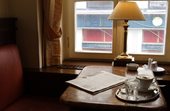
What the pub is to London and the sidewalk café to Paris, the coffeehouse is to Vienna: a central meeting place to exchange ideas, hear news, and linger over a libation of one kind or another. Since the 17th century, Vienna’s coffeehouses have been an integral part of the sophisticated, polyglot cultural and political capital of the Hapsburg empire.
Locals know the legend by heart: coffee first came to Vienna in 1683, when the Turkish army laid siege to Vienna but were overcome by the imperial forces. The Turks beat a hasty retreat and left much of their supplies behind, including several sacks of mysterious beans. The legend goes on to tell of Koschitzky, a Polish army courier who had spent time in the Ottoman Empire and knew that the beans were not camel food, but something much more valuable. He asked if he could keep the sacks in lieu of pay and proceeded to open a small coffeehouse near St. Stephen’s Cathedral in the heart of Vienna.
The rest is history. Caffeine suited the energetic, eclectic Viennese, and soon much of daily commerce and politics was centered on the growing number of elegant coffeehouses in the capital. In the 19th century, coffeehouses served the same role for Viennese men as London clubs did for their English peers: one’s coffeehouse affiliation was a key hallmark of identifying who a Viennese was, what his politics were, and what interests he pursued. Many of the famous coffeehouses are still open today: Sigmund Freud pondered the mysteries of the human psyche in Café Landtmann, while Austrian politician Peter Altenberg made speeches at the Café Central where a statue has been erected in his honor. Leon Trotsky and other liberal thinkers and writers plotted world revolution at Café Griensteidl.
Coffeehouse tradition dies hard, and modern-day Vienna carefully preserves the rituals and traditions of its coffeehouse culture, so much so that UNESCO included Viennese coffeehouse culture in its list of Intangible Cultural Heritages in 2011.
Coffee is still served on a silver tray with a glass of water by professional waiters in formal attire. The privilege to sit in one of the old coffeehouses doesn’t come cheap, so do as the Viennese do and linger for a few hours, read, or just ponder the mysteries of something. And feel Viennese.
Viennese Coffee Terminology
Brainer: coffee with milk
Melange: coffee with hot milk
Obers: coffee with cream
Mokka: strong, concentrated coffee like espresso
Kapuziner: a double “shot” of mokka with a hood of cream
Schwarzer: black coffee
Kaffeinfreir Kaffe: Decaf
Alexander+Roberts serves up delectable trips to Eastern Europe and Austria of all kinds including the elegant escorted,
Grand Capitals of Eastern Europe by Rail.